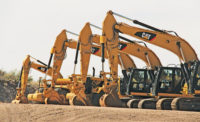Economists are fairly optimistic about construction activity in 2016. Dodge Data & Analytics is forecasting a 5.5% increase in construction starts in 2016, and FMI, PCA and others are forecasting similar gains (see ENR 11/16 p. 20). However, ENR predicts the pop in the markets will translate into a small ping in inflation.
|
Related Link:
4th Quarterly Cost Report |
ENR’s 2016 cost forecast is for its Building Cost Index to end next year with a 1.8% annual gain, after increasing 1.5% this year and 2.9% in 2014. ENR’s Construction Cost Index is expected to rise 2.5% next year, following a 2.0% increase in 2015 and a 2.7% increase in 2014.
This year’s inflation was much lower than anticipated a year ago, due to very weak materials-price escalation. Both the structural-steel and cement component of ENR’s cost indexes declined 1.4% this year, while lumber prices rose just 1.0%. ENR is looking for cement and lumber prices to rebound 4.7% and 8.5%, respectively. However, structural-steel prices are predicted to continue to decline another 3.7% in 2016, according to ENR’s forecast of the materials components of its cost indexes. Materials makes up 34% of the BCI and 19% of the CCI.
The other side of the equation is how crucial labor costs are to forecasting ENR’s cost indexes. Union labor rates make up 81% of the CCI and 66% of the BCI. ENR attempts to get a handle on 2016 labor-cost trends by looking at multiyear trade agreements that already have been negotiated for next year, all of which are tracked by the Construction Labor Research Council.
CLRC’s survey of agreements shows first-year settlements with a median annual increase of 2.8% for laborers. ENR tracked a 2.7% increase for these workers. Likewise, CLRC’s median increase for bricklayers, carpenters and ironworkers was 2.6% in 2015, while ENR reported a 2.7% gain for this group of workers.
CLRC reports that the negotiated increase in multiyear contracts for 2016 averages 3.0% for laborers and 2.6% for the three skilled trades. ENR is using those increases to forecast the labor component of its CCI and BCI.
Structural Collapse
For construction costs in 2016, the biggest news is analysts’ prediction of a dramatic drop in structural-steel and reinforcing-bar prices. IHS Global Insight is forecasting another 15.6% decline in structural-steel prices next year. This drop follows a 13.2% decline reported by Platts Metals Week for 2015 prices. Rebar prices are expected to fall 23.2% next year, after declining 10.8% this year, according to these sources.
“What is really driving steel prices down is the collapse in scrap prices, which are down nearly 50% from their recent peak,” says John Anton, steel analyst for IHS Global Insight. Scrap is the primary source material for structural steel and rebar in the U.S.
“Demand in the U.S. is good, but prices in the rest of the world are low and people started to import,” Anton says. “Structural-steel prices are being reset to where they were 10 years ago.”
Lumber prices were pummeled in 2015 by a combination of severe winter weather, weak demand from China, increased competition from Russia due to the weak ruble and a port strike on the West Coast, which temporarily halted exports, says Dave Fortin, senior economist for wood products for the forecasting firm RISI. He estimates that the average mill price for western spruce fell 20% this year. RISI predicts these prices will rebound 25% in 2016. “That will just bring prices back to 2014 levels,” Fortin says.
Cement prices are forecast to increase another 4.7% next year, says Deni Koenhemsi, construction materials analyst for Global Insight. That will be down from an 8% increase this year, she says. Due to a revision in its database, ENR’s cement component actually declined 1.4% in 2015, but ENR is incorporating Global Insight’s prediction into its forecast.




Post a comment to this article
Report Abusive Comment